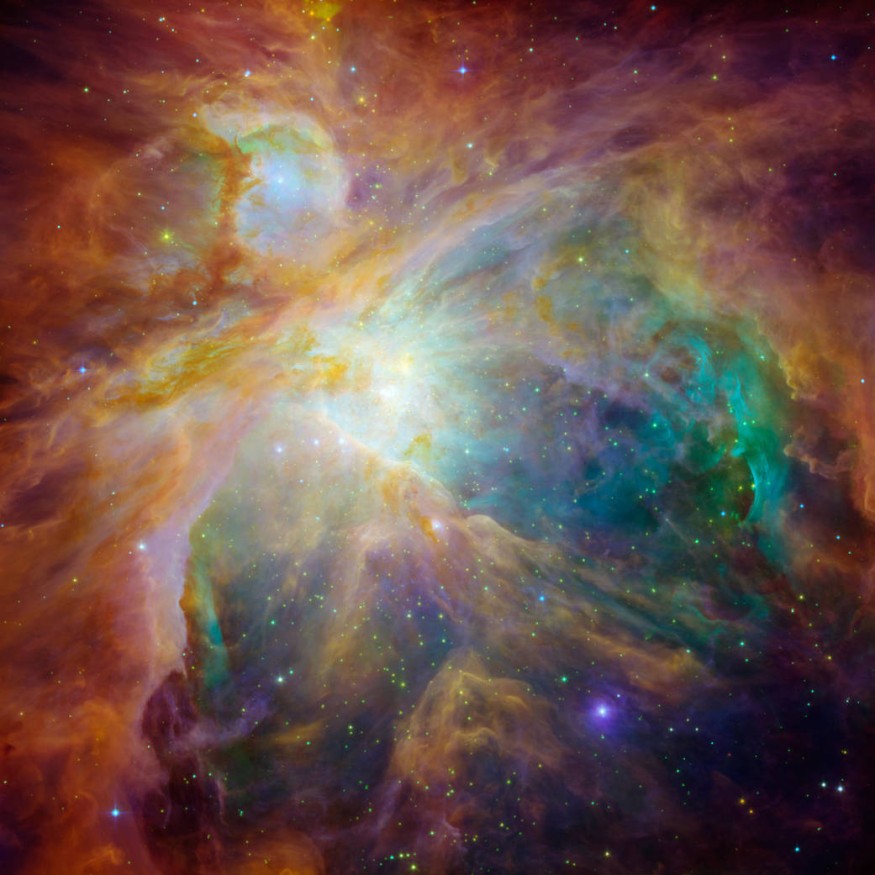Nevertheless, a NASA-analysed snapshot from the Hubble Space Telescope showed chaos at the center of the nebula.
The nebula, which consists of dust and steam, appears amazing from a distance, spinning red, green, and yellow.
Molecules such as hydrogen, sulfur, and hydrocarbons are all present in the Orion Nebula.
According to Phys.org, the molecules are super-heated by surrounding stars that producing strong reactions.
In this combined picture of the Orion Nebula, as shown by the Hubble Space Telescope and the Spitzer Space Telescope, the space agency said gaseous swirls of hydrogen, sulfur, and hydrocarbons cradle a series of newborn stars.

Orion Nebula's Heart: More Than You'll Ever Know
Here, four stars stand out at the center of the nebula. Collectively, because of its trapezoid form, it is classified as the Trapezium or Trapezium Cluster.
The Italian astronomer Galileo Galilei first spotted it. There are many stars in this cluster, and with a small- to medium-sized telescope, you can normally see about six of them.
You may note that, on the one hand, the Orion Nebula has a little knot of steam. It's the M43. Discovered by Jean-Jacques d'Ortous de Mairan, a French astronomer, it is often referred to as the De Marian Nebula.
Probably, it is not a distinct nebula, rather an offshoot of the nebula of Orion. A huge, blue-white giant star illuminates this glob of hydrogen, around 20 times more massive than our planet. Another curious yet less well-known cloud of gas exists at the top of Orion's blade.
More generally, due to the dark clouds here that mimic a human running, it is linked to by its catalog number, Sharpless 279, and by its famous tag, the Running Man Nebula.
It is much fainter than the Orion Nebula and further down (about 1,500 light-years). It is so small that it is actually very challenging to spot visually in a telescope. Still, because of its unusual form, it is a common subject for astrophotographers. The Running Guy, like the Orion Nebula, involves many young stars.
JWST's Missions
The James Webb Space Telescope (JWST) is expected to take over this year from Hubble, launching on 31 October 2021.
Despite years of setbacks, NASA is now optimistic that it will bring its premier telescope into Earth's orbit this year.
The JWST can continue to unravel the secrets of the Cosmos and eventually discover intelligent existence. Scientists are hopeful.
The infrared system is so strong that it can enter the farthest realms and the earliest moments in time and space again.
And the JWST has the power to search thousands of planets for evidence of alien activity, even if they are thousands of light-years distant. After James Webb, the telescope, NASA's second president, who worked from 1961 to 1968 and played a significant role in the Apollo missions.
As well as seeing farther through space, the content of water, carbon dioxide, and other elements in an exoplanet's environment, a world beyond our solar system, can be precisely determined.
It would also teach scientists all about the scale and distance from their home stars that these planets are.
Check out more news and information on Space on Science Times.












